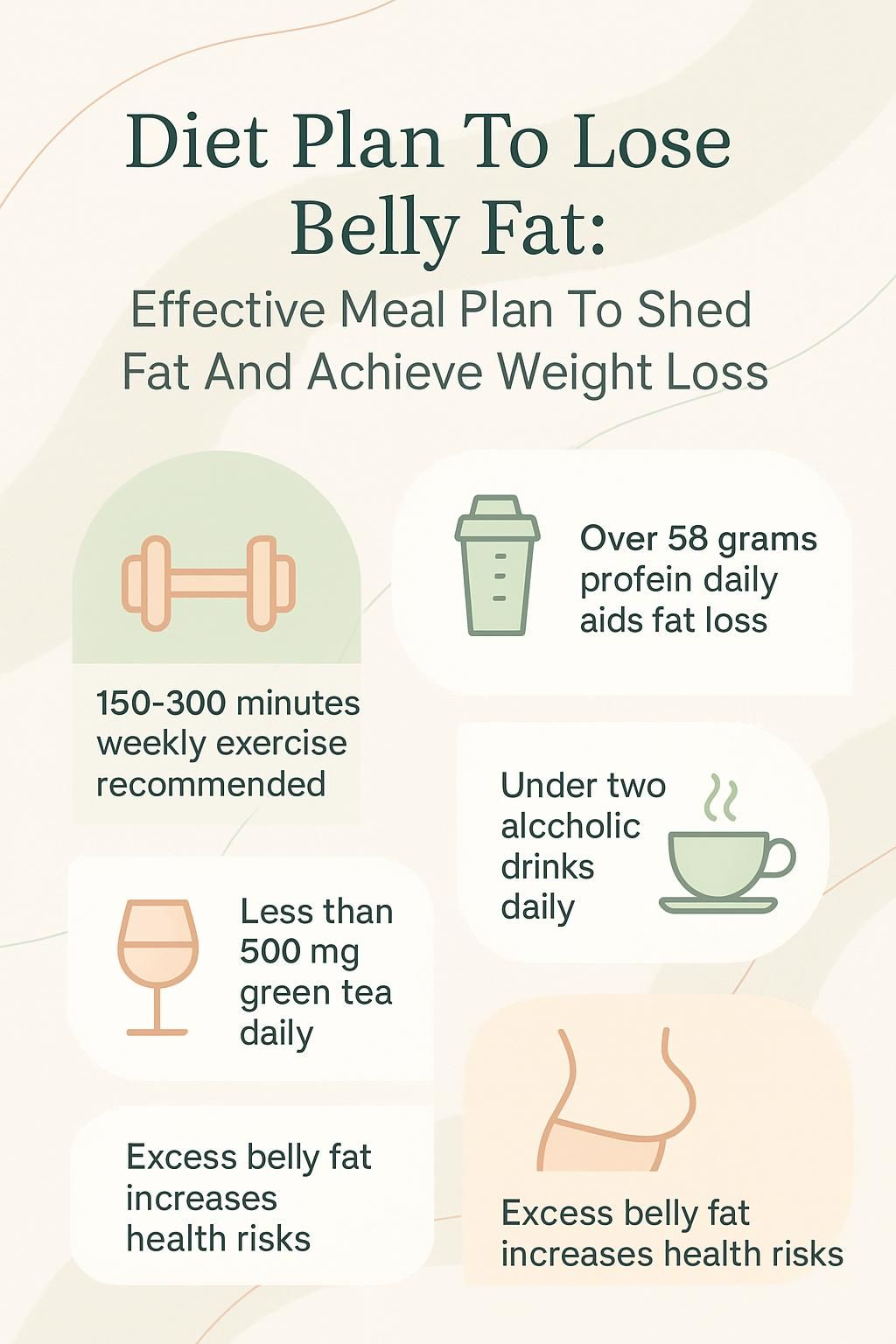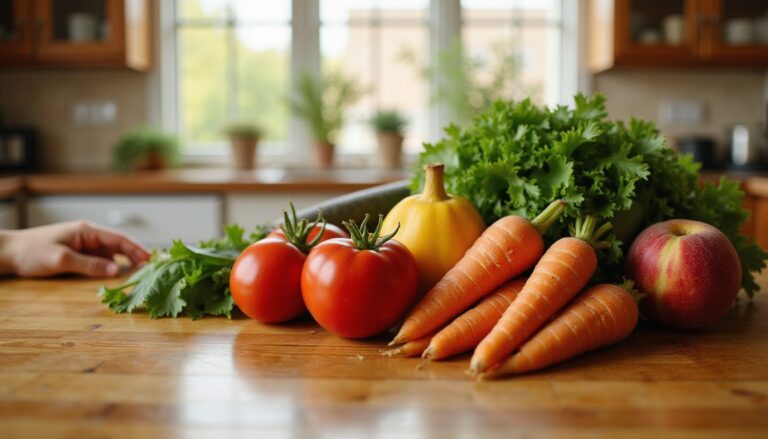Diet Plan To Lose Belly Fat: Effective Meal Plan To Shed Fat And Achieve Weight Loss
Our Nutrition Assistant AI Suite will transform your body. You will lose fat, get toned, and build muscle. Gain confidence and optimal health.
If you feel stuck with stubborn belly fat, you are not alone. Extra fat around your waist can be hard to change, yet the right diet plan and steady habits can help you lose belly fat and improve health. Visceral fat, the deeper fat around organs, raises your risk for type 2 diabetes and heart disease.
This guide walks you through simple food choices, smart meal prep, and a practical meal plan. You will find steps you can follow today, plus small changes that add up over time.
Key Takeaways
- Create a caloric deficit, eat fewer calories than you burn, and aim for 150 to 300 minutes of exercise weekly. This helps reduce both the fat under your skin and deeper visceral fat.
- High protein intake, at least 58 grams per day, fiber at 29 to 41 grams per day, and healthy fats from nuts, seeds, avocado, olive oil, and fatty fish support abdominal fat loss.
- Skip sugary drinks, avoid trans fats in packaged foods, reduce refined carbs like white bread, and limit alcohol to no more than two drinks daily.
- Probiotic foods, for example yogurt or kimchi, support gut health. Green tea intake under 500 mg daily for twelve weeks has been linked with a smaller waist in research by Kwak and Shin, 2022.
- Studies, including Emamat et al., 2024, link excess visceral fat with higher risks of type 2 diabetes, heart disease, metabolic syndrome, and death, even when Body Mass Index looks normal.

What Are the Different Types of Belly Fat?

Belly fat collects in two main places, under the skin and deep in the abdomen. Each type affects your health differently. Knowing the difference helps you build a meal plan to lose belly fat with better results.
What Is Subcutaneous Belly Fat?
Subcutaneous fat sits just below your skin. You can pinch it around your waist or lower stomach. It stores energy and insulates your body.
Research shows subcutaneous fat is less tied to chronic disease than visceral fat because it does not press on organs like your liver or intestines. It often rises when you take in more calories than you burn, especially from added sugar and ultra-processed foods.
Choosing whole grains, lean protein, and fiber helps you manage weight without feeling deprived. Carrying some subcutaneous fat is common, but healthier habits still support long-term weight management.
Most people have both types of belly fat. Focusing only on appearance can hide important health risks.
Next, learn why visceral fat is riskier for your long-term health.
What Is Visceral Belly Fat?
Visceral fat forms deeper in your abdomen and wraps around your liver, pancreas, and intestines. It acts like an active tissue and releases chemicals that can disrupt normal organ function.
This hidden fat raises the risk of heart disease, type 2 diabetes, some cancers, and metabolic problems. Genetics, hormone shifts like higher cortisol, diets high in refined carbs or saturated fats, certain medicines, and low activity can increase visceral fat.
Healthy eating with vegetables, lean protein, and regular aerobic activity helps shrink waist size and lower harmful fat stores. Following guidance in the Dietary Guidelines for Americans, 2020 to 2025, supports better blood pressure and insulin sensitivity as you reduce visceral fat.
Why Is Belly Fat Dangerous for Your Health?
Visceral fat sits around your organs, which makes it more harmful than fat under your skin. It raises the risk of type 2 diabetes, fatty liver disease, and heart disease.
For example, Emamat et al., 2024, linked both visceral and subcutaneous fat with higher blood pressure and abnormal cholesterol. Saad et al., 2022, reported higher all-cause death rates with more visceral fat. You can have a normal BMI and still carry risky levels of abdominal fat.
Cutting calories modestly, eating more fiber, and reducing sugary drinks support fat loss and better long-term health. If you have a medical condition or take prescription drugs, speak with a healthcare professional before making major changes.
Key Principles for Losing Belly Fat
Fat loss depends on consistent habits. A steady eating plan, enough activity, and small daily wins move the needle.
How Does a Caloric Deficit Help Lose Belly Fat?
A caloric deficit means you eat fewer calories than your body uses. Your body then taps stored fat for energy, including fat in the belly area. Pair calorie reduction with regular movement to burn more calories and protect muscle.
Aim to burn at least 1,000 calories per week through exercise. Tracking food with an app or journal raises awareness and makes habits stick. A higher fiber, lower fat pattern can reduce visceral fat more than just cutting calories alone.
Why Is a Balanced Diet Important for Fat Loss?
A balanced diet helps you burn calories efficiently and stay satisfied. Fill your plate with lean protein, healthy fats like olive oil and avocado, complex carbs such as whole grains and beans, and plenty of leafy greens and fruit.
The Mayo Clinic Healthy Weight Pyramid suggests making vegetables and salad the largest part of your meal. A 7-day plan near 1,500 calories per day, with at least 58 grams of protein and 29 grams of fiber, supports fat metabolism and preserves muscle during weight loss.
Swapping packaged foods for lean protein, yogurt, nuts, broccoli, and fish supports circulation and heart health, which helps you lose belly fat over time.
What Role Does Physical Activity Play in Losing Belly Fat?
Regular movement speeds fat loss. Aerobic exercise like brisk walking or cycling burns calories and can reduce subcutaneous and visceral fat.
Research from 2015 showed 300 minutes per week cut more belly fat than 150 minutes. Strength training builds muscle and preserves lean tissue while you diet. A 2014 study found the biggest drop in visceral fat when resistance work and cardio were combined. Aim for at least 30 minutes daily, and mix both styles for the best results.
Which Foods Help Reduce Belly Fat?
Some foods make it easier to stick to a healthy lifestyle. They keep you full, control blood sugar, and support your goal to lose weight.
What Are the Best High-Protein Foods for Fat Loss?
Protein reduces hunger and helps maintain muscle as you lose body fat. It also increases peptide YY, a hormone that promotes fullness.
- Choose lean meats like chicken breast or turkey. They are low in calories and rich in protein.
- Eat fatty fish such as salmon and mackerel twice weekly for protein and omega-3 fats.
- Have eggs at breakfast for a complete protein that fights mid-morning hunger.
- Pick Greek yogurt or cottage cheese. One cup delivers about 15 to 20 grams of protein and may support gut health.
- Use beans, lentils, and tofu for plant protein and gut-friendly fiber.
- Add whey protein to smoothies after workouts for quick recovery and appetite control.
- Snack on a small handful of almonds or peanuts. They provide protein and healthy fats.
Intakes above 58 grams of protein per day, as noted by Jamshidi et al., 2022, are linked with less abdominal fat. These choices support bones, metabolism, and heart health while moving you toward better body composition.
Which Healthy Fats Should You Eat to Lose Belly Fat?
Healthy fats increase fullness and support metabolic health. They also improve the taste of meals, which helps you stay consistent.
- Use extra-virgin olive oil for cooking or salads. It contains anti-inflammatory monounsaturated fats.
- Add avocado to bowls, wraps, or toast for satisfying fats and fiber.
- Choose nuts like almonds, walnuts, or pistachios. Regular intake is linked to smaller waists in research such as Cubas-Basterrechea et al., 2022.
- Stir chia or ground flaxseed into yogurt or smoothies for omega-3s.
- Eat salmon or mackerel twice a week for protein and heart-friendly fats.
- Use a small amount of coconut oil if you like its flavor, and keep portions modest.
- Keep daily fat in the range of 60 to 92 grams, consistent with the Dietary Guidelines for Americans, 2020 to 2025.
Choosing these fats supports weight management and helps reduce belly fat while protecting your heart.
How Do Fiber-Rich Foods Aid Belly Fat Reduction?
Fiber helps you feel full with fewer calories. Soluble fiber, which forms a gel in your gut, slows digestion and steadies blood sugar.
- Soluble fiber blunts quick sugar spikes and reduces cravings for sweet foods and drinks.
- Eating 10 grams more soluble fiber daily was linked with 3.7 percent less belly fat over five years in adults.
- Good sources include oats, barley, beans, apples, oranges, and leafy greens.
- Aim for 29 to 41 grams of total fiber per day to support fat loss.
- Fiber-rich foods reduce hunger after meals and help limit snacking.
- Beans and lentils may also support a healthier gut microbiome.
- Pair fiber intake with at least 150 minutes of weekly activity for better results.
What Are Low-Glycemic Index Carbohydrates?
Low-glycemic carbs digest slowly. They steady energy and help control appetite, which supports fat loss in the abdomen.
- Whole grains like oats, barley, and brown rice are lower on the glycemic index. In the Framingham Heart Study, higher whole grain intake linked with a 17 percent lower risk of belly fat.
- Leafy vegetables like spinach and kale supply vitamins and slower-digesting carbs without big sugar spikes.
- Nuts give fiber and healthy fats for steadier energy between meals.
- Sweet potatoes and beans deliver complex carbs and nutrients that curb cravings for sweetened drinks.
- Replacing refined grains with quinoa or buckwheat can lower metabolic disease risk, as shown by Sawicki et al., 2021.
- Choosing these foods instead of white bread or sugary snacks lowers fast glucose spikes that drive fat storage.
- Many people find appetite is easier to control when meals center on low-glycemic foods.
Low-glycemic choices support steady energy and play a clear role in long-term belly fat reduction.
How Do Probiotic-Rich Foods Support Belly Fat Loss?
Probiotics are helpful bacteria that support digestion and weight control. A balanced gut may reduce inflammation tied to visceral fat.
- Include yogurt, kefir, sauerkraut, and kimchi to add live cultures to your diet.
- Some Lactobacillus strains, such as fermentum, amylovorus, and gasseri, show promise for shrinking belly fat in studies.
- Improved microbiota can increase nutrient absorption and support immune function.
- A healthier gut may reduce cravings for sugary snacks and drinks.
- Reviews from 2018 found regular probiotic intake over 12 weeks decreased abdominal fat mass.
- Weight control can also reduce sleep apnea risk by lowering abdominal pressure on airways.
Combining probiotics with lean protein and vegetables strengthens your plan to lose belly fat.
Why Include Fatty Fish Like Salmon and Mackerel?
Fatty fish supply protein and omega-3 fats, which support heart health and may reduce inflammation tied to visceral fat. Eating two to three servings each week works well for most people.
Options include salmon, herring, sardines, mackerel, and anchovies. If you avoid animal products, consider algae-based omega-3 supplements to cover this nutrient gap. These choices fit a delicious healthy eating pattern that supports exercise and energy.
Which Foods Should You Avoid to Lose Belly Fat?
A few foods make fat loss harder. Cutting them back protects your organs and helps your plan work better.
Why Avoid Sugary Beverages and Snacks?
Sodas, sweet teas, punches, and many juices add fast calories. An 8-ounce serving of unsweetened apple juice has about 24 grams of sugar, half from fructose.
Liquid calories do not fill you up like solid food. High fructose intake raises liver fat and drives visceral fat storage. Reducing sweet cocktails and mixers cuts calories without losing flavor from whole foods.
What Are Trans Fats and Processed Foods?
Trans fats are artificial fats used to extend shelf life in some packaged foods. Eating them increases inflammation, insulin resistance, heart disease risk, and abdominal fat.
Check labels for the words partially hydrogenated oil. Many processed items, such as pastries, chips, and frozen meals, also pack excess sodium and added sugars. Replacing them with whole foods supports your weight-loss plan and metabolic health.
How Do Refined Carbohydrates Affect Belly Fat?
Refined carbs, including white bread and pastries, raise blood sugar quickly. Your body releases more insulin, and over time this signals more fat storage around your waist.
The Framingham Heart Study links high refined grain intake with more abdominal fat, while whole grains are tied to a 17 percent lower risk. If you have prediabetes or PCOS, swapping to whole grains can make progress easier and steadier.
Choose oats, brown rice, beans, and vegetables at meals. These swaps support better blood sugar control and long-term weight management.
Why Limit Excessive Alcohol Consumption?
Heavy drinking raises belly fat, especially around the waist. A 2023 study showed a clear link between higher alcohol intake and more waist fat. Earlier research found that people who drink daily but in small amounts carry less belly fat than those who binge.
The Dietary Guidelines for Americans recommend no more than two drinks per day for men and one for women. Alcohol adds empty calories, can raise cortisol, and may slow metabolism. Cutting back can speed your results and support better sleep and recovery.
Sample 7-Day Meal Plan to Lose Belly Fat
This 7-day meal plan uses protein, fiber, and healthy fats to help you lose belly fat. Adjust portions to your calorie needs. If you have a medical condition or use insulin or other medicines, talk with your healthcare provider before starting.
What to Eat on Day 1: High-Protein Breakfast, Balanced Lunch, Light Dinner
Start with a high-protein breakfast. An omelet with spinach, tomatoes, and low-fat cheese offers roughly 20 grams of protein. Add Greek yogurt or a small handful of nuts for extra staying power.
At lunch, try grilled chicken over greens with quinoa and avocado. For dinner, bake salmon and pair it with broccoli or zucchini noodles tossed in olive oil. Day 1 targets about 1,480 calories, 62 grams protein, and 41 grams fiber to curb evening cravings.
What to Eat on Day 2: Fiber-Focused Meals with Healthy Fats
Breakfast: oatmeal with chia seeds and sliced almonds for fiber and healthy fats. Lunch: quinoa salad with black beans, avocado, cherry tomatoes, olive oil, and lemon juice.
Dinner: grilled salmon with steamed broccoli and a drizzle of extra-virgin olive oil. Snacks: Greek yogurt with ground flaxseed, or celery with natural almond or peanut butter. Day 2 provides about 1,504 calories, 62 grams protein, 122 grams carbs with 33 grams fiber, 92 grams fat, and nearly 1,940 milligrams sodium.
Many people report steadier energy and fewer cravings with this balance of fiber and fats.
What to Eat on Day 3: Probiotic-Rich Snacks and Low-Carb Dinners
Pick probiotic snacks like yogurt, kefir, sauerkraut, or kimchi to support gut health. For dinner, go lower in carbs with grilled salmon or baked chicken plus steamed broccoli or spinach. Add a small portion of almonds or walnuts for healthy fats.
Daily targets: about 1,526 calories, 58 grams protein, 163 grams carbs, and 35 grams fiber. Keep sodium near 1,858 milligrams. Drink water through the day. A cup of unsweetened green tea in the evening adds antioxidants and may support weight management.
What to Eat on Day 4: Lean Proteins and Whole Grains
Choose lean proteins such as skinless chicken breast, turkey, tofu, or fish. Pair them with whole grains like brown rice, quinoa, or oats for fiber and minerals.
Aim for about 1,491 calories, 65 grams of protein, 130 grams of carbs, and 32 grams of fiber. Keep fat near 86 grams and sodium near 1,753 milligrams. Many people feel fuller longer when they swap refined grains for whole grains.
What to Eat on Day 5: Omega-3 Rich Meals with High Fiber
Breakfast around 490 calories, with 18 grams of fiber. Try oatmeal with chia seeds, walnuts, and fresh berries for omega-3s and fiber.
Lunch: grilled salmon or mackerel with leafy greens, chickpeas, and quinoa. Dinner: baked trout with steamed broccoli and a side of lentils. This pairing of fish and fiber-rich plants supports heart health and helps reduce inflammation markers.
What to Eat on Day 6: Balanced Macros and Hydration
Keep meals balanced for steady energy. Target about 1,455 calories, 70 grams protein, 158 grams carbs, 29 grams fiber, and 64 grams fat.
Lunch or dinner idea: grilled chicken breast with brown rice and steamed broccoli, plus a spoon of olive oil or a sprinkle of nuts. Breakfast: Greek yogurt with berries and chia seeds. Sip water all day, aiming for at least eight cups. Season with herbs to limit sodium to roughly 1,666 milligrams.
What to Eat on Day 7: Nutrient-Dense Meals and Portion Control
Shift focus to nutrient density and careful portions. Aim for about 1,510 calories, 84 grams protein, 174 grams carbs, 40 grams fiber, 60 grams fat, and roughly 1,704 milligrams sodium.
Build plates with grilled chicken or tofu, brown rice or quinoa, and plenty of vegetables. Add a small portion of almonds for fullness. Use smaller plates and measure servings so intake stays on track.
Additional Tips to Accelerate Belly Fat Loss
Small daily habits help your plan run smoother, just like a steady rhythm in training.
How Does Drinking Green Tea Help Belly Fat Loss?
Green tea contains caffeine and EGCG, an antioxidant that may increase fat burning. Research shows that staying under 500 mg daily for twelve weeks can reduce body weight and waist size.
Kwak and Shin, 2022, linked regular green tea drinking with less abdominal obesity. Replacing sugary drinks with unsweetened tea can also cut calories and improve workout energy.
Why Is Staying Hydrated Important?
Water supports metabolism and digestion. Drinking water before or during meals helps you feel full, which can lower calorie intake.
Aim for at least eight cups per day. Swap soda and juice with sparkling water or unsweetened herbal tea. Many people find afternoon water breaks reduce boredom snacking.
What Is Intermittent Fasting and How Does It Help?
Intermittent fasting cycles eating and fasting periods. The 16:8 method allows an eight-hour eating window and a sixteen-hour fast. Some people prefer a 24-hour fast once or twice weekly.
Research suggests intermittent fasting can lower insulin levels and increase fat use for energy. Pairing IF with higher protein intake may improve weight loss. If you notice dizziness, irritability, or poor sleep, adjust the plan or stop and seek guidance from a healthcare professional.
How Does Restful Sleep Affect Fat Loss?
Getting at least seven hours of quality sleep helps regulate hunger hormones. A large 2006 study of over 68,000 women found that sleeping under five hours per night was linked with more weight gain compared to seven hours.
If you struggle with snoring or daytime sleepiness, ask your clinician about sleep apnea. Treating sleep issues can help reduce visceral fat and support your eating plan.
How Can Managing Stress Levels Reduce Belly Fat?
Stress raises cortisol, a hormone that increases appetite and can push fat storage to the waist. People with larger waists often show bigger cortisol spikes under pressure.
Short daily sessions of deep breathing, yoga, or meditation can lower stress and reduce cravings for high-calorie foods. Over time, calmer routines make it easier to maintain a healthy diet.
What Are the Benefits of Following a Belly-Fat-Loss Diet?
A focused eating plan supports energy, confidence, and health. You also build habits that last.
How Does This Diet Improve Metabolic Health?
Higher protein and fiber intake support better blood sugar and cholesterol. The Mayo Clinic approach encourages vegetables, fruits, whole grains, beans, and healthy fats like olive oil and avocado to keep metabolism active and cravings lower.
Swapping afternoon sweets for fruit or nuts can prevent energy dips. Many people notice steady energy and better digestion within a few weeks.
How Does Belly Fat Loss Reduce Chronic Disease Risk?
Losing visceral fat lowers your risk for type 2 diabetes, heart disease, and high blood pressure. Smaller waistlines usually mean better insulin sensitivity and less inflammation.
Modest weight loss can bring meaningful health gains. This is one of the most reliable ways to reduce your risk of certain long-term conditions.
How Can Losing Belly Fat Boost Appearance and Confidence?
As abdominal fat drops, your waist often looks slimmer and clothes fit more comfortably. Muscle definition becomes easier to see as overall body composition improves.
Feeling stronger and lighter boosts confidence at work, at home, and during social events. These wins make it easier to stay active and keep a healthier life.
Frequently Asked Questions
Find simple answers to common questions about your eating plan and weight management.
How Long Does It Usually Take to Lose Belly Fat?
Progress varies based on diet, exercise, sleep, and your starting point. The Mayo Clinic Diet has a two-week phase where many people lose 6 to 10 pounds, then a steady phase targeting one to two pounds per week.
Results around the waist often improve over several months. Consistency with your eating plan and physical activity supports gradual, lasting change.
Can Specific Exercises Target Belly Fat?
Spot reduction is a myth. Ab moves like crunches strengthen muscles but do not remove fat from one area.
Combine resistance training with aerobic exercise like brisk walking, running, or cycling. This mix improves body composition and helps reduce visceral fat more effectively than ab workouts alone.
Do Supplements Help with Belly Fat Loss?
Some probiotics, including Lactobacillus fermentum, amylovorus, and gasseri, have early evidence for reducing abdominal fat. Results vary, and more research is needed.
Always talk with a healthcare professional before using supplements, especially if you have a medical condition or take medications.
Conclusion
A clear diet plan, consistent physical activity, and steady habits can help you lose belly fat and support your health. Focus on lean protein, fiber-rich foods, healthy fats, and low-glycemic carbs. Limit sugary drinks, refined grains, and excess alcohol.
Stay hydrated, sleep at least seven hours, manage stress, and consider green tea or probiotic foods. These steps make a strong weight-loss plan you can follow long term.
This content is for educational purposes and is not medical advice. If you have health conditions, especially diabetes or heart disease, consult a registered dietitian or your clinician before changing your diet.
FAQs
1. What foods should I include in a diet plan to lose belly fat and achieve weight loss?
A balanced meal plan for reducing abdominal fat includes lean animal proteins like chicken or fish, whole grains such as brown rice or oats, fresh produce including leafy greens and berries, and healthy fats from nuts or olive oil. Research shows that diets high in fiber and protein help reduce visceral fat while supporting overall health.
2. How many calories should I eat daily to shed belly fat effectively?
To lose body mass around the waistline, most adults need to create a calorie deficit of 500 to 750 calories per day compared with their maintenance intake. For example, if your current requirement is 2,000 calories per day for weight stability, aim for about 1,250 to 1,500 calories daily. Studies confirm that gradual reductions are safer than extreme cuts.
3. Can exercise alone remove belly fat without changing my eating habits?
Physical activity helps burn energy but does not target specific areas like the abdomen unless paired with dietary changes. Evidence-based reviews indicate combining regular aerobic movement such as brisk walking with a structured eating pattern leads to greater decreases in central adiposity than exercise alone.
4. Are there any risks linked with rapid weight loss meal plans targeting abdominal reduction?
Quick-fix regimens often lack essential nutrients; they may cause fatigue or muscle loss instead of sustainable results. Clinical data suggest slow progress through steady caloric restriction combined with nutrient-rich foods supports long-term success while minimizing health risks.
Summary: Effective strategies for losing midsection body mass involve consuming nutrient-dense meals rich in protein and fiber; maintaining an appropriate calorie deficit; pairing physical activity with dietary adjustments; and avoiding unsafe rapid-loss approaches supported by credible scientific evidence.







